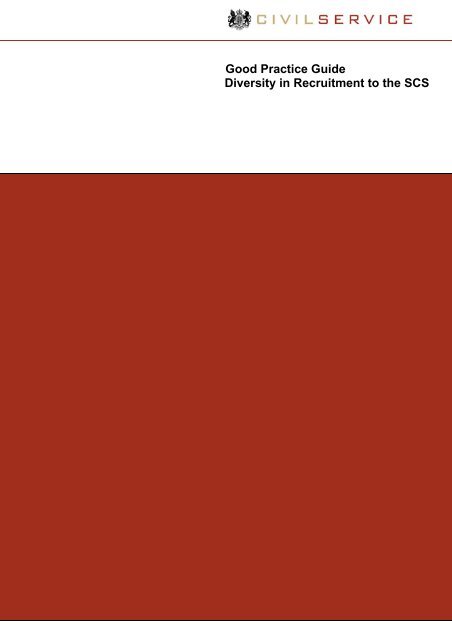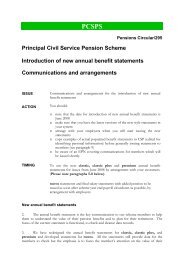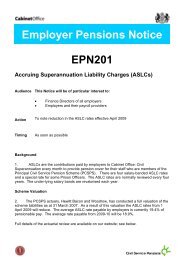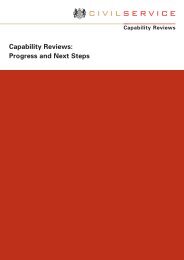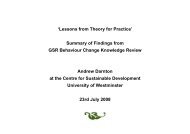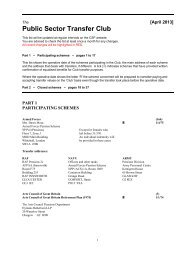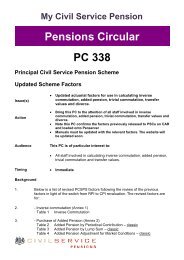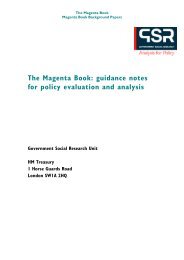Good Practice Guide Diversity in Recruitment to ... - The Civil Service
Good Practice Guide Diversity in Recruitment to ... - The Civil Service
Good Practice Guide Diversity in Recruitment to ... - The Civil Service
- No tags were found...
Create successful ePaper yourself
Turn your PDF publications into a flip-book with our unique Google optimized e-Paper software.
<strong>Good</strong> <strong>Practice</strong> <strong>Guide</strong><strong>Diversity</strong> <strong>in</strong> <strong>Recruitment</strong> <strong>to</strong> the SCS
CONTENTSForeword 1Bill Jeffrey, Chair, <strong>Diversity</strong> Champions NetworkExecutive Summary 2Accountability for recruitment 4Job descriptions and person specifications 5Work<strong>in</strong>g with search firms 7Appropriate and cost effective recruitment advertisements 11Us<strong>in</strong>g a brand when recruit<strong>in</strong>g 12Integrated candidate management 13Engag<strong>in</strong>g with the candidate 14Flexibility around the <strong>in</strong>terview 15Use of assessment centres 15Manag<strong>in</strong>g high calibre <strong>in</strong>dividuals follow<strong>in</strong>g recruitment 16Us<strong>in</strong>g Jobs Onl<strong>in</strong>e (formerly the <strong>Civil</strong> <strong>Service</strong> <strong>Recruitment</strong> Gateway) 20Management Information 21Conclusion 23Annex: How the guidance came about 24
Foreword<strong>The</strong> <strong>Civil</strong> <strong>Service</strong> is committed <strong>to</strong> creat<strong>in</strong>g a more <strong>in</strong>clusive and diverse environmentfor its entire workforce. Promot<strong>in</strong>g Equality, Valu<strong>in</strong>g <strong>Diversity</strong> – A Strategy for the<strong>Civil</strong> <strong>Service</strong> builds on what we have already achieved and reflects the drive <strong>to</strong>ma<strong>in</strong>stream equality and diversity further <strong>in</strong><strong>to</strong> every aspect of our bus<strong>in</strong>ess.We have made steady progress on representation over the last decade but muchmore rema<strong>in</strong>s <strong>to</strong> be done. As the <strong>Civil</strong> <strong>Service</strong> <strong>Diversity</strong> Champion, I chair the<strong>Diversity</strong> Champions’ Network which is made up of board-level members from eachgovernment department. One of the aims of the Network is <strong>to</strong> identify and sharegood practice. We therefore commissioned Moloney Search <strong>to</strong> help us developguidance <strong>to</strong> support the recruitment of people from under-represented groups by:rais<strong>in</strong>g awareness on the importance of <strong>in</strong>tegrat<strong>in</strong>g diversity good practicethroughout the recruitment process;help<strong>in</strong>g recruiters and l<strong>in</strong>e managers be more creative and proactive <strong>in</strong>address<strong>in</strong>g diversity;challeng<strong>in</strong>g current th<strong>in</strong>k<strong>in</strong>g; anddevelop<strong>in</strong>g the capability of people <strong>in</strong>volved <strong>in</strong> SCS recruitment.I hope that you f<strong>in</strong>d the guide a stimulat<strong>in</strong>g read and useful <strong>in</strong> help<strong>in</strong>g <strong>to</strong> <strong>in</strong>crease thediversity of the <strong>Civil</strong> <strong>Service</strong>.Sir Bill JeffreyPermanent SecretaryM<strong>in</strong>istry of Defence and <strong>Civil</strong> <strong>Service</strong> <strong>Diversity</strong> Champion1
EXECUTIVE SUMMARYOverall<strong>Diversity</strong> targets are more likely <strong>to</strong> be achieved if clear leadership andaccountability for delivery are identified.A clear understand<strong>in</strong>g of the diversity targets should be achieved <strong>in</strong> eachdepartment. This <strong>in</strong>formation should be used <strong>to</strong> <strong>in</strong>form the recruitmentstrategy for each vacancy.Identify<strong>in</strong>g a VacancyRigorous analysis of the job description and job specification should beundertaken <strong>to</strong> ensure that they are relevant <strong>to</strong> the current situation and oftenmay need <strong>to</strong> be re-written. <strong>The</strong> person specification needs <strong>to</strong> be analysed <strong>to</strong>make sure that the identified 'essential criteria' are truly relevant <strong>to</strong> the job andnot just seek<strong>in</strong>g <strong>to</strong> replicate the current or previous job holder’s style or way ofdo<strong>in</strong>g th<strong>in</strong>gs.Design<strong>in</strong>g a <strong>Recruitment</strong> ProcessEnsure all processes used are diversity proofed (<strong>in</strong>clud<strong>in</strong>g any cultural bias <strong>in</strong>assessment centres).Consider and decide the most appropriate recruitment strategy for the post(s)open for recruitment.Ensure that there is capability <strong>to</strong> address any disability access issues.Develop a clear understand<strong>in</strong>g of the brief <strong>to</strong> be given <strong>to</strong> search consultantson what diversity outcomes are expected at all stages of the process – makethis a part of the recruitment criteria. Set the consultants aspirational targets.Have an open and honest conversation with prospective consultants at theoutset <strong>to</strong> assess how capable they may be <strong>in</strong> help<strong>in</strong>g <strong>to</strong> achieve theseaspirations, e.g. how capable are they of widen<strong>in</strong>g their search brief and wha<strong>to</strong>utreach work are they prepared <strong>to</strong> undertake. Use this knowledge <strong>to</strong> <strong>in</strong>formthe decision about which consultants <strong>to</strong> use.Involve a search partner early and spend time with them help<strong>in</strong>g themunderstand your department. Bear <strong>in</strong> m<strong>in</strong>d that short timescales will workaga<strong>in</strong>st achiev<strong>in</strong>g more diversity.Be proactive <strong>in</strong> engag<strong>in</strong>g with the consultants on outcomes, and be prepared<strong>to</strong> review the process if you feel they are not do<strong>in</strong>g enough.2
Nurture good relations with search firms who are proactive about diversity.Take action <strong>to</strong> make the ‘bus<strong>in</strong>esses of your department more attractive <strong>to</strong> allpeople, and seek ways of communicat<strong>in</strong>g this <strong>to</strong> diverse communities.Assess your advertis<strong>in</strong>g strategy <strong>to</strong> ensure that all avenues for reach<strong>in</strong>gdiverse communities are utilised. Seek advice from media agencies.Ensure that people identified through various methods are brought <strong>to</strong>gether <strong>to</strong>go through the same process.Provide the name of a key person who can give more background <strong>to</strong> the joband the <strong>Civil</strong> <strong>Service</strong>. This is particularly important for candidates from othersec<strong>to</strong>rs.Ensure people on recruitment panels have a good understand<strong>in</strong>g of diversityissues and good practice <strong>in</strong> fair and equitable employment.Ensure recruitment panels have representation from under-representedgroups. If this is not feasible arrangements should be made for a diversityexpert <strong>to</strong> participate.Selection and mak<strong>in</strong>g a job offerWhen mak<strong>in</strong>g the f<strong>in</strong>al selection decision, look critically at whether anyunconscious bias is affect<strong>in</strong>g the decision. Often we tend <strong>to</strong> select <strong>in</strong> our ownimage: this is likely <strong>to</strong> work aga<strong>in</strong>st achiev<strong>in</strong>g greater diversity.Post-selection, the names of all applicants should be kept on a database forfuture reference, <strong>in</strong>clud<strong>in</strong>g those people from under-represented backgroundswho were close <strong>to</strong> be<strong>in</strong>g appo<strong>in</strong>ted. Prior permission must be sought from the<strong>in</strong>dividuals concerned and data protection issues must be taken <strong>in</strong><strong>to</strong> account.Follow<strong>in</strong>g <strong>Recruitment</strong>Undertake an evaluation of how well the recruitment process worked andwhether there are any lessons for the future.Put <strong>in</strong> place effective development and tra<strong>in</strong><strong>in</strong>g opportunities with<strong>in</strong> yourdepartment <strong>to</strong> develop the <strong>in</strong>ternal ‘pipel<strong>in</strong>e’ for under-represented groups.3
ACCOUNTABILITY FOR RECRUITMENT<strong>The</strong> <strong>Civil</strong> <strong>Service</strong> is committed <strong>to</strong> diversity. However the achievement of diversitytargets can appear even more challeng<strong>in</strong>g when there are other bus<strong>in</strong>ess prioritiessuch as headcount and f<strong>in</strong>ancial restrictions. In order <strong>to</strong> address this, there needs <strong>to</strong>be a consistency of ownership or drive at senior management levels <strong>to</strong> take diversityforward; people need <strong>to</strong> know why it is important not just <strong>in</strong> general terms, but how itl<strong>in</strong>ks <strong>to</strong> bus<strong>in</strong>ess objectives.L<strong>in</strong>e managers can sometimes attach less importance and give less time <strong>to</strong>recruitment than their counterparts <strong>in</strong> the private sec<strong>to</strong>r. In a number of large,private sec<strong>to</strong>r organisations with some of the best track records <strong>in</strong> this area CEOshave been <strong>in</strong>volved <strong>in</strong> appo<strong>in</strong>tments up <strong>to</strong> 3 or 4 levels below them.It is important that accountability for recruitment rests with l<strong>in</strong>e managers because: this ensures that there is clear ownership and authority at a local level <strong>to</strong> take<strong>in</strong>novative action <strong>in</strong> pursuit of achiev<strong>in</strong>g diversity <strong>in</strong> the SCS; HR has a key strategic and advisory role <strong>to</strong> play, but not the authority <strong>to</strong>prioritise the achievement of diversity targets <strong>in</strong> l<strong>in</strong>e with other bus<strong>in</strong>esspriorities; and L<strong>in</strong>e managers can keep the issue on the bus<strong>in</strong>ess agenda and ‘role model’the appo<strong>in</strong>tment of diverse <strong>in</strong>dividuals.Issues <strong>to</strong> be AddressedAccountability for recruitment and the development of senior people shouldrest with l<strong>in</strong>e managers and this should be reflected <strong>in</strong> job descriptions andannual performance management objectives. HR Direc<strong>to</strong>rs should act <strong>in</strong> astrategic and support capacity provid<strong>in</strong>g guidance, consistency and goodpractice as necessary.Overarch<strong>in</strong>g diversity targets for improv<strong>in</strong>g the number of women, BME anddisabled <strong>in</strong>dividuals with<strong>in</strong> the <strong>Civil</strong> <strong>Service</strong> should be communicated <strong>to</strong> allstaff by senior leaders expla<strong>in</strong><strong>in</strong>g how these l<strong>in</strong>ks <strong>in</strong><strong>to</strong> the annual bus<strong>in</strong>essobjectives of each department.Each department should cont<strong>in</strong>ue <strong>to</strong> build diversity objectives <strong>in</strong><strong>to</strong> its bus<strong>in</strong>essplan for a given year and spell out how achiev<strong>in</strong>g these fit with departmentalbus<strong>in</strong>ess objectives.It is critically important that all l<strong>in</strong>e managers feel personally accountable forachiev<strong>in</strong>g their department’s diversity targets. To achieve this, at thebeg<strong>in</strong>n<strong>in</strong>g of each year, all l<strong>in</strong>e managers should know what they must do <strong>to</strong>contribute <strong>to</strong> the divisional targets and understand how they will be measuredon it.<strong>The</strong>se issues should be explicitly reflected <strong>in</strong> departmental and personalperformance review schemes.4
L<strong>in</strong>e managers should lead recruitment <strong>in</strong>terviews for their direct reports andfurther down the management l<strong>in</strong>e when possible.L<strong>in</strong>e managers should be tra<strong>in</strong>ed <strong>in</strong> diversity and <strong>in</strong>clusion issues.DO YOU…Discuss the importance of recruit<strong>in</strong>g under-represented managers anddevelop<strong>in</strong>g diverse leaders as a regular agenda item at bus<strong>in</strong>ess meet<strong>in</strong>gswith a report on the extent <strong>to</strong> which targets are be<strong>in</strong>g met?Act as a role model for diversity by own<strong>in</strong>g and driv<strong>in</strong>g the policy, regularlyre<strong>in</strong>forc<strong>in</strong>g how the activity fits with bus<strong>in</strong>ess objectives?THE USE OF JOB DESCRIPTIONS AND PERSON SPECIFICATIONSOften, when a role vacancy becomes apparent, there can be a tendency <strong>to</strong> ‘dust off’an exist<strong>in</strong>g job description and person specification rather than assess<strong>in</strong>g thevacancy from scratch. This can have the discrim<strong>in</strong>a<strong>to</strong>ry effect of not fully consider<strong>in</strong>gthe extent <strong>to</strong> which the specification is actually relevant <strong>to</strong> the job, and can workaga<strong>in</strong>st <strong>in</strong>troduc<strong>in</strong>g new blood <strong>to</strong> the team or consider<strong>in</strong>g the extent <strong>to</strong> which the rolecould be delivered <strong>in</strong> a different way. <strong>The</strong>re is also a tendency <strong>to</strong> recruit <strong>in</strong><strong>to</strong> whatthe role has become (as the current <strong>in</strong>cumbent has grown and developed), ratherthan the essential requirements of the role itself.In most recruitment exercises the first po<strong>in</strong>t of contact with a candidate is the releaseof a job description and a person specification that concentrates on essential workexperience and the professional skills for government requirements. This oftendoesn't offer the opportunity <strong>to</strong> br<strong>in</strong>g the role alive. While this is often unavoidable, itcan have the effect of narrow<strong>in</strong>g the field of potential candidates.DO YOU…Consider the extent <strong>to</strong> which a role could be reshaped <strong>to</strong> attract morediverse candidates, without bias<strong>in</strong>g the documentation <strong>in</strong> favour ofparticular <strong>in</strong>dividuals?Focus <strong>in</strong> job descriptions and person specifications on the skillscandidates need <strong>to</strong> be successful <strong>in</strong> the job, rather than work experiencethey have, as this will extend the pool of possible candidates?5
Consider focus<strong>in</strong>g the job description and person specification ontransferable skills that will be of benefit <strong>to</strong> the <strong>Civil</strong> <strong>Service</strong> as a wholerather than a specific role?Rigorously assess the 'essential criteria' for relevance <strong>to</strong> the role <strong>in</strong> termsof delivery and remov<strong>in</strong>g unnecessary qualifications?Take a manageable risk when recruit<strong>in</strong>g people who may br<strong>in</strong>g widerrelevant experience <strong>to</strong> the job, but may not be drawn from traditionalpools?Consider how you might make the job attractive <strong>to</strong> a disabled person?Consider how you might make the job attractive <strong>to</strong> job-sharers and parttimeworkers? For example, advertis<strong>in</strong>g all posts as open <strong>to</strong> part-time/jobshare/flexible work<strong>in</strong>g unless there is a robust bus<strong>in</strong>ess reason why this isimpossible. See l<strong>in</strong>k www.civilservice.gov.uk on the Jobs tab for guidanceon job-shar<strong>in</strong>g and case studies of successful job-sharers at all grades.CASE STUDYRECRUITMENT<strong>The</strong> Crown Prosecution <strong>Service</strong> (CPS) has implemented a number of changes <strong>to</strong> itsrecruitment process <strong>to</strong> ensure that its diversity targets are met.CPS has simplified its recruitment process, bas<strong>in</strong>g it on clear job descriptions,person specifications and work based assessments and implement<strong>in</strong>g a processof cont<strong>in</strong>uous review and improvement. Diverse panels are used dur<strong>in</strong>g eachstage of recruitment.<strong>The</strong> use of open competition for posts, where such competition is likely <strong>to</strong> yield amore diverse applicant pool, has been maximized.Informal and proactive outreach activities take place <strong>to</strong> promote CPS as anemployer of choice, e.g. career talks.<strong>Recruitment</strong> advertis<strong>in</strong>g has been radically overhauled and a more modern<strong>in</strong>clusive image that conveys commitment <strong>to</strong> equality and diversity is now used.This refreshed approach <strong>to</strong> advertis<strong>in</strong>g has attracted commendations and<strong>in</strong>dustry awards.Contract expectations for search consultants on equality and diversity are set.Ownership for deliver<strong>in</strong>g local diverse workplaces was given <strong>to</strong> local managers6
CASE STUDYWORKING WITH DISABLED PEOPLEIn response <strong>to</strong> low representation of employees with disability, the BBC launched the‘Access all areas’ <strong>in</strong>itiative. One element of this is ‘Extend’, a work placementscheme for talented people with disabilities. <strong>The</strong> scheme offers 16 weeks of paidwork placements. <strong>The</strong> ma<strong>in</strong> benefits of this scheme have been that it has proved anentry po<strong>in</strong>t <strong>in</strong><strong>to</strong> broadcast<strong>in</strong>g and has also helped <strong>to</strong> educate managers on becom<strong>in</strong>gmore comfortable and confident with policy and good practice <strong>in</strong> relation <strong>to</strong> disabledemployees.As a follow up <strong>to</strong> this, the BBC Access Unit has been set up <strong>to</strong> provide <strong>in</strong>formationand services <strong>to</strong> BBC disabled staff and their managers. <strong>The</strong> ma<strong>in</strong> services that areprovided by the unit are: assessments, support and liaison with other departments.<strong>The</strong> purpose of the unit is <strong>to</strong> ensure that disabled employees are given a levelplay<strong>in</strong>g field.WORKING WITH SEARCH FIRMSExecutive search firms (head-hunters) are <strong>in</strong>volved <strong>in</strong> many senior appo<strong>in</strong>tmentswith<strong>in</strong> the <strong>Civil</strong> <strong>Service</strong>. Consider carefully what your market options are, andwhether there is a strong enough <strong>in</strong>ternal market which could be drawn on <strong>in</strong>itially.However <strong>in</strong>creas<strong>in</strong>gly a tw<strong>in</strong>-track approach – seek<strong>in</strong>g potential <strong>in</strong>ternally andexternally simultaneously – is be<strong>in</strong>g used.Executive search firms can make a real difference <strong>to</strong> <strong>in</strong>creas<strong>in</strong>g the mix of diversecandidates who are <strong>in</strong>terviewed for, and jo<strong>in</strong> the SCS. A measure of success will bewhen diversity is an <strong>in</strong>tegral part of the brief<strong>in</strong>g process and that departments areproactive <strong>in</strong> manag<strong>in</strong>g this process and relationship.<strong>The</strong>re is a fundamental difference between executive search firms and recruitmentagencies. <strong>Recruitment</strong> agencies hold candidates on their files that are activelylook<strong>in</strong>g for a job change and speak <strong>to</strong> them <strong>in</strong> advance of recruitment projects.Executive search firms work <strong>to</strong> a specific client brief and make direct approaches <strong>to</strong>candidates who are not actively look<strong>in</strong>g <strong>to</strong> make a move. <strong>The</strong>re are also search andselection agencies: the selection side of their bus<strong>in</strong>esses specialises <strong>in</strong> handl<strong>in</strong>gadvertised recruitment.With some changes <strong>to</strong> current practices, executive search firms and otherrecruitment agencies can be deployed more effectively by the recruiter <strong>to</strong> identifyand attract diverse candidates. Executive search firms can provide better value formoney <strong>to</strong> departments <strong>in</strong> their search for diverse candidates if departments look <strong>to</strong>make better use of the skills these firms offer.<strong>The</strong> check list below gives an <strong>in</strong>dication of when best <strong>to</strong> use a search firm, agency oradvertis<strong>in</strong>g when recruit<strong>in</strong>g:7
When <strong>to</strong> use a search firmSEARCHFIRMNeed<strong>in</strong>g<strong>to</strong> targeta specificaudienceVery broadbriefrequir<strong>in</strong>g awide skillsetShorttimescalesA desire <strong>to</strong>use thevacancy <strong>to</strong>do broaderPR AGENCY ADVERTISE A difficultandspecificskill setrequiredSearch firms should look <strong>to</strong> provide more than a list of <strong>to</strong>p quality diverse candidates.<strong>The</strong>y should map the market on each job they undertake and provide added valueconsultancy services on many aspects of the recruitment processes.<strong>Recruitment</strong> assignments for the SCS, and particularly the early research phaseswhich are vitally important <strong>in</strong> f<strong>in</strong>d<strong>in</strong>g a wide range of candidates, are currently carriedout under great time pressure which mitigates aga<strong>in</strong>st identify<strong>in</strong>g a diverse pool of<strong>in</strong>dividuals - diverse candidates tend <strong>to</strong> have comparatively lower profiles and needmore search work <strong>to</strong> identify them. By contrast the later stages of an assignment arefar more protracted and risk los<strong>in</strong>g good candidates through lack of momentum.Those who are responsible for recruitment can establish relationships with one ormore search firms outside the context of specific searches. Most search firms wouldbe happy <strong>to</strong> expla<strong>in</strong> the services they offer <strong>in</strong> a general way outside a specificrecruitment assignment. Recruiters could also f<strong>in</strong>d out which search firms otherdepartments use and share <strong>in</strong>formation.Before select<strong>in</strong>g a search firmEnsure you have a full and thorough brief.Assess the current diversity make up of both the team and department therecruit will be jo<strong>in</strong><strong>in</strong>g.Have a note of the aspirational diversity targets for your department.Have conversations with relevant stakeholders regard<strong>in</strong>g specific diversitychallenges your department might face and how the vacancy could appeal <strong>to</strong>diverse audiences.Identify and discuss the <strong>in</strong>volvement of key diversity role models who thesearch firm could talk about and who could potentially meet candidates.8
When select<strong>in</strong>g a search firmRequest a list of successful assignments where they have placed candidatesfrom under-represented groups over the past 3 years.Ask what systems they use <strong>to</strong> track their success <strong>in</strong> this area and ask <strong>to</strong> seethe results for the last year.Take up references from other organisations.Consider the extent <strong>to</strong> which they are resistant/defensive/enthusiastic whenasked questions around diversity.Be clear with consultants about the level of expertise, time and quality of <strong>in</strong>putwhich will be dedicated <strong>to</strong> your search, <strong>in</strong>clud<strong>in</strong>g details about how extensivethe search will be.Review the extent <strong>to</strong> which they ‘map’ the market <strong>in</strong> the areas they aresearch<strong>in</strong>g <strong>in</strong> and share this <strong>in</strong>formation with their client.Ask what experience they have with recruit<strong>in</strong>g <strong>in</strong> the geographical arearequired.When brief<strong>in</strong>g a search firmIntroduce them <strong>in</strong><strong>to</strong> the process early on.Spend time help<strong>in</strong>g them understand your department, the his<strong>to</strong>rysurround<strong>in</strong>g the vacancy, its <strong>in</strong>terfaces and what a successful candidateshould deliver etc.Ask them <strong>to</strong> spend time with other people <strong>in</strong> the department where thevacancy is, <strong>to</strong> help them understand the role <strong>in</strong> more detail.Set aspirational targets for them <strong>to</strong> work <strong>to</strong>wards (for example, ask the firm <strong>to</strong>provide at least one female and one BME candidate on the shortlist). Be veryclear on how diverse you expect their lists <strong>to</strong> be and what this means <strong>to</strong> you.Agree where the search is <strong>to</strong> take place and which communities <strong>in</strong> particularshould be targeted.If the search does not go accord<strong>in</strong>g <strong>to</strong> planEnsure the search firm understands the issues raised <strong>in</strong> not produc<strong>in</strong>g adiverse list.Encourage them <strong>to</strong> speak <strong>to</strong> you throughout the process about any issuesrelat<strong>in</strong>g <strong>to</strong> diversity and if they are not manag<strong>in</strong>g <strong>to</strong> “reach out” <strong>to</strong> the right9
candidates. This will allow you <strong>to</strong> re-group and bra<strong>in</strong>s<strong>to</strong>rm before the end ofthe research phase.If the f<strong>in</strong>al list produced is not diverse have a check list of questions and areas<strong>to</strong> look <strong>in</strong><strong>to</strong> <strong>to</strong> understand the reasons why and work through these <strong>in</strong>collaboration with the search firm.If you feel from look<strong>in</strong>g at their research work that they did not attempt <strong>to</strong>contact enough diverse candidates or did not map the market of potential<strong>in</strong>dividuals fully enough (which can lead <strong>to</strong> a restricted field), consider thefollow<strong>in</strong>g: Withhold<strong>in</strong>g their shortlist payment, if the agreed outputs have not beenachieved. Not us<strong>in</strong>g them aga<strong>in</strong> on similar projects.DO YOU…Ask the search firm <strong>to</strong> advise and help draw up the job description?Research suggests that work<strong>in</strong>g <strong>in</strong> partnership <strong>in</strong> this way leads <strong>to</strong> a muchmore successful, diverse slate of candidates <strong>to</strong> choose from. Allow sufficient time for a search? You should allow a m<strong>in</strong>imum of 6weeks from ‘sign off’ of the brief <strong>to</strong> presentation of a full and diverseshortlist. Occasionally, if there is a big area <strong>to</strong> target, 6-8 weeks may beneeded.Always need <strong>to</strong> ask for a long list? You could rely on the search firm <strong>to</strong>provide a balanced and diverse shortlist and audit or carry out ‘spotchecks’ on their processes on occasions.CASE STUDYGETTING MORE VALUE FROM A SEARCH FIRMA major bank entered a strategic partnership with a lead<strong>in</strong>g search firm <strong>to</strong> review thebank's recruitment practices. <strong>The</strong> search firm:Took brief<strong>in</strong>gs on all of the bus<strong>in</strong>ess units with<strong>in</strong> the bank so that they were fully<strong>in</strong>formed on all aspects of these organisations.Interviewed all Manag<strong>in</strong>g Direc<strong>to</strong>rs and HR Direc<strong>to</strong>rs <strong>in</strong> these bus<strong>in</strong>ess units <strong>to</strong>discuss all their recruitment policies and potential issues.Ran focus groups and workshops with senior groups and specifically the bank’ssenior female talent network.<strong>The</strong> outcome was new guidel<strong>in</strong>es <strong>in</strong>corporat<strong>in</strong>g proactive suggestions for talentpipel<strong>in</strong>e policies and advise on how <strong>to</strong> br<strong>in</strong>g more women <strong>in</strong><strong>to</strong> the organisation.10
APPROPRIATE AND COST EFFECTIVE RECRUITMENT ADVERTISEMENTSOpenly advertis<strong>in</strong>g a forthcom<strong>in</strong>g appo<strong>in</strong>tment is advisable <strong>in</strong> order <strong>to</strong> reach a widerange of candidates. It can also be very expensive. You need <strong>to</strong> be clear aboutwhether it is cost effective <strong>in</strong> comparison <strong>to</strong> other methods you could use <strong>to</strong> attractdiverse candidates, and consider alternative ways of advertis<strong>in</strong>g, <strong>in</strong>clud<strong>in</strong>g mak<strong>in</strong>gmore use of onl<strong>in</strong>e facilities.It is important <strong>to</strong> consider not only whether <strong>to</strong> rely on a search firm <strong>to</strong> deliver yourdiverse candidates but which medium gives you the statistically <strong>in</strong>creased likelihoodof reach<strong>in</strong>g a high calibre diverse talent pool. Several targeted, smaller adverts <strong>in</strong>select press could be more effective than one large ma<strong>in</strong> stream advertisement.In order <strong>to</strong> ensure you are gett<strong>in</strong>g good value for moneyCheck with the media agency the target audience figures.Look at the results of adverts for similar posts across different media.Build up a portfolio of success s<strong>to</strong>ries where adverts have attracted diversecandidates and work out what common fac<strong>to</strong>rs they had. Was it the word<strong>in</strong>gof the advert or the fact it was placed <strong>in</strong> the correct publication?Consider us<strong>in</strong>g established networks <strong>to</strong> spread the word about potentialvacanciesIssues <strong>to</strong> be addressedAsk partner recruitment agencies (if used) for advice when advertis<strong>in</strong>g, even ifthey are not handl<strong>in</strong>g a search at the same time.Look <strong>to</strong> build relationships with a media agency (as well as recruitmentagencies that might handle the response) that has expertise and knowledgeregard<strong>in</strong>g which positions attract the best responses, and can advise on‘diversity reach’. <strong>The</strong>y should be able <strong>to</strong> provide guidance on the best medium<strong>to</strong> use <strong>to</strong> provide the best results.Review the word<strong>in</strong>g of all advertisements <strong>to</strong> make sure they are <strong>in</strong>clusive; andconsider runn<strong>in</strong>g a focus group <strong>in</strong>ternally with diversity groups <strong>to</strong> test whetherword<strong>in</strong>g is off-putt<strong>in</strong>g. Adverts should convey the themes of pace, passion,professionalism and pride.Concentrate on skill sets rather than work experience <strong>to</strong> attract and capturethe widest diverse audience.Ensure the advertisement covers any support you are able <strong>to</strong> give disabledpeople.11
CASE STUDIESEFFECTIVE ADVERTISING AND VALUE FOR MONEYCase Study A<strong>The</strong> Regional Development Agencies had placed a series of advertisements <strong>in</strong> localand national press <strong>to</strong> try <strong>to</strong> reach a diverse audience of potential candidates whowould be <strong>in</strong>terested <strong>in</strong> sitt<strong>in</strong>g on RDA boards.However, <strong>in</strong> two regions, there was a real paucity of diverse talent who applied and aspecific lack of any credible female candidates.Senior M<strong>in</strong>isters were concerned about the fac<strong>to</strong>rs that were lead<strong>in</strong>g <strong>to</strong> this andcommissioned Moloney Search <strong>to</strong> conduct a survey of over 600 women <strong>in</strong> the tworegions. <strong>The</strong> researchers were asked <strong>to</strong> check whether it was location, tim<strong>in</strong>g, theappeal of the posts, was it not <strong>in</strong>clusive, off putt<strong>in</strong>g <strong>to</strong> women etc. One of the ma<strong>in</strong>f<strong>in</strong>d<strong>in</strong>gs was that 65% of the women had not seen the advert <strong>in</strong> the first place.Case Study BIBM has conducted <strong>in</strong> depth research around how <strong>to</strong> become more attractive <strong>to</strong>talented women. Based on this research a number of programmes have beendeveloped, <strong>in</strong>clud<strong>in</strong>g one specific <strong>to</strong> mak<strong>in</strong>g their advertis<strong>in</strong>g more effective:IBM is profiled on the website run by the women's organisation, Aurora, and uses thewebsite <strong>to</strong> advertise job vacancies. Aurora feeds back comments while a campaignis runn<strong>in</strong>g, check<strong>in</strong>g whether women are attracted <strong>to</strong> it and that the message is right.<strong>The</strong> site was also used <strong>to</strong> post s<strong>to</strong>ries and role model profiles.Advertis<strong>in</strong>g campaigns are tracked and responses are measured then fed back <strong>in</strong><strong>to</strong>the recruit<strong>in</strong>g process. As a result, IBM <strong>to</strong>ok out the word ‘IT’ <strong>in</strong> an advertis<strong>in</strong>gcampaign for consultants as it discouraged women from apply<strong>in</strong>g.USING A BRAND WHEN RECRUITINGMany departments use their own brand when advertis<strong>in</strong>g or on application forms.However, wider benefits can be achieved by us<strong>in</strong>g the <strong>Civil</strong> <strong>Service</strong> brand as awhole, <strong>in</strong>clud<strong>in</strong>g publicis<strong>in</strong>g the appo<strong>in</strong>tment of under-represented people acrossWhitehall. Government and the SCS tend <strong>to</strong> be grouped <strong>to</strong>gether <strong>in</strong> people’s m<strong>in</strong>dsas a ‘big grey unknown employer’ and an exposition of the work<strong>in</strong>gs of the <strong>Civil</strong><strong>Service</strong> would make the organisation far more accessible <strong>to</strong> people not alreadyfamiliar with it.12
Consider what is best for you and <strong>in</strong>vest <strong>in</strong> build<strong>in</strong>g an employer brand and developstrong and positive PR around it.CASE STUDIESBRANDINGAurora believes employee reputation is key <strong>to</strong> attract<strong>in</strong>g diverse people. In theirexperience the most constructive th<strong>in</strong>g organisations can do is <strong>to</strong> be seen <strong>to</strong> beputt<strong>in</strong>g someth<strong>in</strong>g back <strong>to</strong> the m<strong>in</strong>ority group they are <strong>in</strong>terested <strong>in</strong> employ<strong>in</strong>g andbuild up an employer brand.Accenture really mean what they say about look<strong>in</strong>g after their female employees anduse it <strong>in</strong> their brand<strong>in</strong>g messages very effectively - e.g. they give paid time off for IVFand they make sure they are very visible at women’s events.<strong>The</strong> West Midlands Police developed a strong brand, had a big successful PRcampaign and were able <strong>to</strong> recruit very successfully.Sa<strong>in</strong>sbury’s and McDonalds have transformed their hir<strong>in</strong>g of women by extensivemarket<strong>in</strong>g collateral and build<strong>in</strong>g a really strong message around be<strong>in</strong>g an employerof choice for women.Organisations also need <strong>to</strong> convey the message that they are actively recruit<strong>in</strong>g anddo have vacancies. Deloitte have had 600 vacancies a year <strong>in</strong> the past <strong>in</strong> theirvarious groups, and they use this as a positive message for the brand as a whole.INTEGRATED CANDIDATE MANAGEMENTCandidates who respond <strong>to</strong> advertisements should be <strong>in</strong>tegrated with thoseidentified through a search. Both sets of candidates should be handled at all stagesby the search firm so the process is fair and even, whatever route the candidatecomes through.Issues <strong>to</strong> be addressed when manag<strong>in</strong>g a selection process<strong>The</strong> tim<strong>in</strong>g of the advertisement should not be agreed <strong>in</strong> isolation from thework of the search firm. <strong>The</strong> advertisement should run <strong>in</strong> parallel <strong>to</strong> anyresearch conducted.A full audit trail of the search as well as the advertisement should beexpected.Your department or an external agency or consultancy could be givenresponsibility for own<strong>in</strong>g all high-calibre diverse candidates who make it <strong>to</strong>shortlist stage by either route (search firm or advertisement).13
<strong>The</strong>se candidates could then be contacted for other vacancies that come up.If departments are prepared <strong>to</strong> <strong>in</strong>vest <strong>in</strong> this, time can also be spentnetwork<strong>in</strong>g with these <strong>in</strong>dividuals, identify<strong>in</strong>g other candidates through themand spread<strong>in</strong>g a positive PR message among their peers.ENGAGING WITH A CANDIDATEResearch has shown that recruitment <strong>to</strong> the SCS can sometimes be process driven.This does not always address the needs of candidates from outside the <strong>Civil</strong> <strong>Service</strong>who may require a detailed exposition of what work<strong>in</strong>g <strong>in</strong> Whitehall is about.Whichever recruitment method is be<strong>in</strong>g used it can be very effective <strong>to</strong> engage thecandidate at several po<strong>in</strong>ts throughout the process. This has particularly positiveeffects on attract<strong>in</strong>g candidates from under-represented groups. <strong>The</strong> more effort andtime that goes <strong>in</strong><strong>to</strong> hir<strong>in</strong>g them the more likely it is that they will accept an offer andspread a positive message about the process. Informal feedback about the processamongst diverse candidates can have a very positive impact on recruitment.If candidates have been approached by an executive search firm they are probablynot look<strong>in</strong>g for a job and they may have been placed <strong>in</strong> many of their roles <strong>to</strong> datethrough powerful advocacy: they may expect this aga<strong>in</strong>.L<strong>in</strong>e managers and other key staff should look <strong>to</strong> spend as much time as possiblewith the candidate at all stages of the <strong>in</strong>terview processDO YOU…Provide examples of role models with<strong>in</strong> your department from similarbackgrounds?Ensure that managers have been tra<strong>in</strong>ed and briefed on reasonableadjustments?Provide someone <strong>to</strong> act as an advocate of the role and your department atfirst round <strong>in</strong>terviews?Offer one-<strong>to</strong>-one <strong>in</strong>formal chats or telephone conversations with thecandidates? <strong>The</strong>se <strong>in</strong>formal conversations can uncover issues orconcerns that can be addressed straightaway, which the formal part of theprocess does not encourage. <strong>The</strong> sessions would need <strong>to</strong> be offered <strong>to</strong> allcandidates <strong>to</strong> make sure the process is fair <strong>to</strong> all.Make the job offer personally? If us<strong>in</strong>g a search partner, this can be doneonce it is clear that the offer is acceptable <strong>to</strong> a candidate. At this stage youshould aga<strong>in</strong> offer <strong>to</strong> meet the person so that any outstand<strong>in</strong>g concernscan be addressed.14
CASE STUDYUSING A RECRUITMENT BUDDYAccenture supports candidates from under-represented groups by provid<strong>in</strong>g a“recruitment buddy” for guidance, usually dur<strong>in</strong>g the second round <strong>in</strong>terview stage ofthe recruitment procedure. This helps <strong>to</strong> ensure that the process is as supportive aspossible and that every candidate has the best opportunity <strong>to</strong> display their truepotential.FLEXIBILITY AROUND THE INTERVIEW<strong>The</strong> current <strong>in</strong>terview processes with<strong>in</strong> departments are not always conducive <strong>to</strong>successful diverse recruit<strong>in</strong>g and can be both <strong>to</strong>o long and <strong>to</strong>o impersonal. <strong>The</strong> useof large <strong>in</strong>terview panels is not common practice outside the public sec<strong>to</strong>r and cansometimes be off-putt<strong>in</strong>g for people who do not have experience of them.DO YOU…Try <strong>to</strong> be as flexible as possible regard<strong>in</strong>g the <strong>in</strong>terview? e.g. time of day,location etc. This would make candidates feel that the organisation isreally <strong>in</strong>terested <strong>in</strong> them and avoids the ‘take it or leave it’ sense conveyedby a fixed arrangement. Access issues will be particularly important <strong>to</strong>disabled people. Ensure that recruitment panels conta<strong>in</strong> <strong>in</strong>dividuals from diversebackgrounds and are not unnecessarily large?USE OF ASSESSMENT CENTRESAssessment centres are often used as part of the recruitment process and can addmore value than <strong>in</strong>terview panels if they are ‘diversity proofed’. Research carried outby Pearn Kandola on behalf of the Home Office <strong>in</strong> August 2004 <strong>in</strong>dicated that themost successful candidates at assessment centres tended <strong>to</strong> be white males whohad previous developmental experiences, often as part of a 'Top Programme'.Issues <strong>to</strong> be addressed when us<strong>in</strong>g assessment centresIt can be very effective when assessors have been tra<strong>in</strong>ed <strong>in</strong> diversity and<strong>in</strong>clusion and this can be particularly helpful when us<strong>in</strong>g competency based<strong>in</strong>terviews.15
Exercises should be designed so they have no adverse impact on diversecandidates (e.g. some women may be less assertive <strong>in</strong> a male dom<strong>in</strong>atedgroup; some BME women may not challenge male authority).Allowances should be made if a candidate has limited experience <strong>in</strong> an areawhen view<strong>in</strong>g an <strong>in</strong>dividual’s performance on a centre.Those who are responsible for recruitment should look <strong>to</strong> ensure that anygroup exercises and psychological tests used are not solely calibrated aga<strong>in</strong>stUK and US norms as this could adversely affect the chances of somecandidates from a BME background or a different culture.Psychological tests are best used as a vehicle <strong>to</strong> ask more questions of acandidate rather than an objective source of data <strong>in</strong> their own right.Assessors should be chosen from among l<strong>in</strong>e managers and HR and ideallyshould come from a diversity of backgrounds.All assessors should be briefed <strong>in</strong> the measures and exercises used at thecentre.DO YOU…Communicate and manage the candidate’s expectations before theassessment centre? Use some of the time at the start of the exercise foradvocacy <strong>to</strong> all candidates and talk through some of the very positiveaspects of work<strong>in</strong>g <strong>in</strong> SCS.Ensure allowances are made <strong>to</strong> cope with any disability a candidate mighthave e.g. dyslexia?MANAGING HIGH-CALIBRE INDIVIDUALS FOLLOWING RECRUITMENTFollow<strong>in</strong>g the recruitment of high-calibre <strong>in</strong>dividuals, particularly those from underrepresentedgroups, it is important that support processes are put <strong>in</strong> place not only <strong>to</strong>aid retention but also <strong>to</strong> demonstrate <strong>to</strong> future potential recruits that the <strong>Civil</strong> <strong>Service</strong>is a good and diverse culture with<strong>in</strong> which <strong>to</strong> work.16
Ideas for manag<strong>in</strong>g new recruitsEach <strong>in</strong>dividual should have a development plan which is reviewed with anexpert <strong>in</strong> leadership development from HR.Schemes <strong>to</strong> enable high potential people <strong>to</strong> shadow others should be<strong>in</strong>troduced along with a ‘buddy’ programme.A department-wide men<strong>to</strong>r<strong>in</strong>g scheme could be set up, offer<strong>in</strong>g men<strong>to</strong>rs <strong>to</strong><strong>in</strong>dividuals from under represented groups. Men<strong>to</strong>r<strong>in</strong>g is where people arepaired with a more experienced person from outside their immediate area <strong>in</strong>an environment of mutual trust. This provides an excellent opportunity <strong>to</strong> form<strong>in</strong>ternal networks.Many Departments use a reverse-men<strong>to</strong>r<strong>in</strong>g scheme. This is where a morejunior member of staff of diverse background shadows a senior executive andgives feedback on how they handled meet<strong>in</strong>gs or other situations, <strong>in</strong>clud<strong>in</strong>greferences and sensitivity <strong>to</strong> diversity. This is a very effective way ofeducat<strong>in</strong>g colleagues and senior managers <strong>in</strong> how <strong>to</strong> handle the more subtleissues of deal<strong>in</strong>g with people different <strong>to</strong> themselves.Establish special <strong>in</strong>terest group websites conta<strong>in</strong><strong>in</strong>g network<strong>in</strong>g <strong>in</strong>formation,job opportunities and development opportunities.Hold regular meet<strong>in</strong>gs for under-represented groups with high profile peoplefrom across your department and external speakers <strong>to</strong>gether with an annualconference.Make full use of the ‘Leaders Unltd’ development scheme when appropriate,as delivered by the National School of Government.DO YOU…Discuss with colleagues <strong>in</strong> other departments the extent <strong>to</strong> which crossdepartmentalmen<strong>to</strong>rs could be used?Engage executive coaches <strong>to</strong> help high potential <strong>in</strong>dividuals build onstrengths?Publicise this development scheme externally <strong>to</strong> attract more candidatesfrom under-represented groups?17
CASE STUDYMANAGING DIVERSE POPULATIONS HOLISTICALLYSafeway Inc was the 2006 Catalyst Award W<strong>in</strong>ner for its ‘Champion<strong>in</strong>g Change forWomen: An Integrated Strategy’ Initiative that led <strong>to</strong> the representation of women atVice President level ris<strong>in</strong>g from 12% (2000) <strong>to</strong> 25% (2005). This was achieved by:Effective communication of the bus<strong>in</strong>ess case for diversity; distribution of leaflets,videos, CEO communication at <strong>to</strong>wn-hall conferences.A structured and formal leadership development plan. Each retail l<strong>in</strong>e manager isset targets for m<strong>in</strong>ority-group candidates that they should advance on<strong>to</strong> the plan.Four leadership network groups—Women, African-American, Asian, andHispanic—have been set up and are open <strong>to</strong> all. <strong>The</strong>y are actively supported bysenior leaders. Networks provide development and visibility.Communication of career development opportunities is transparent and open. HRkeeps a list of high potential <strong>in</strong>dividuals and these are targeted when newopportunities arise. Regular meet<strong>in</strong>gs are held with the high potentials <strong>to</strong> discusscareer <strong>in</strong>terests and potential opportunities. L<strong>in</strong>e managers encourage m<strong>in</strong>oritygroups <strong>to</strong> nom<strong>in</strong>ate themselves for ‘stretch positions’.Formal men<strong>to</strong>r<strong>in</strong>g programme for all employees. Many mentees are coachedon<strong>to</strong> the leadership development plan.A Work-Life programme.A rigorous accountability framework ensures the management and track<strong>in</strong>g oftargets. Managers are assessed on their progress <strong>to</strong>wards diversity goals. <strong>The</strong>highest rat<strong>in</strong>g affects a manager’s bonus pay by up <strong>to</strong> 10%.18
CASE STUDYMANAGING A DIVERSE PIPELINEA major dr<strong>in</strong>ks company has been very successful <strong>in</strong> hir<strong>in</strong>g senior women. Withstrong leadership and motivation from the <strong>to</strong>p of the organisation, they put theirsuccess down <strong>to</strong> the follow<strong>in</strong>g fac<strong>to</strong>rs:<strong>The</strong>y l<strong>in</strong>k diversity <strong>in</strong>itiatives back <strong>to</strong> the organisation’s bus<strong>in</strong>ess objectives andcommercial success.Recruiters also work <strong>in</strong> l<strong>in</strong>e management roles at some po<strong>in</strong>t <strong>in</strong> their career.Understand<strong>in</strong>g behavioural issues rather than what a person should ‘look like’ forcerta<strong>in</strong> roles has helped transform the way they recruit with a marked impact ondiversity.<strong>The</strong>y have family friendly policies and flexibility <strong>in</strong> time off work, with very seniorpeople act<strong>in</strong>g as role models (e.g. a CFO who always works from home on aFriday).<strong>The</strong>y identified roles that could easily be married <strong>to</strong> flexible work<strong>in</strong>g hours andfound that this was a strong motiva<strong>to</strong>r even if people only worked <strong>in</strong> such a rolefor just 12 months. In roles where flexible work<strong>in</strong>g is used, outputs aremeasured.<strong>The</strong>y have <strong>in</strong>vested <strong>in</strong> technology <strong>to</strong> act as a real enabler for work<strong>in</strong>g from home.<strong>The</strong>y have asked diverse groups what they want from their work and reallylistened <strong>to</strong> them.<strong>The</strong>y tackled one area of diversity at a time.<strong>The</strong>y use central talent pools for the <strong>to</strong>p <strong>in</strong>dividuals <strong>in</strong> the organisation.19
CASE STUDYMANAGING DIVERSE POPULATIONSHav<strong>in</strong>g spent much energy <strong>in</strong> attract<strong>in</strong>g new hires from a diverse background, IBM<strong>in</strong>troduced a number of programmes <strong>to</strong> ensure they kept them.Men<strong>to</strong>r<strong>in</strong>g is seen as a valuable way <strong>to</strong> develop women of potential. Allemployees are encouraged <strong>to</strong> take part across the globe through an e-men<strong>to</strong>rweb site.IBM started the ‘Women <strong>in</strong> Bus<strong>in</strong>ess’ network when no other networks of thistype existed. Cross corporate network<strong>in</strong>g brought senior women <strong>to</strong>gether <strong>to</strong>share experiences and men<strong>to</strong>r each other.Best practice roundtables are hosted for Opportunity Now; and IBM hassponsored Everywoman for seven years and promoted the launch of a series ofbooks <strong>to</strong> help women <strong>in</strong> bus<strong>in</strong>ess.IBM also supports other organisations such as Shell, BP, HSBC and Reutersthrough their networks, the BP consortium and the International Women ofExcellence.Keep<strong>in</strong>g track of alumni and then runn<strong>in</strong>g network<strong>in</strong>g events helps them <strong>to</strong> reengageand stay <strong>in</strong> <strong>to</strong>uch with people who do leave and may wish <strong>to</strong> return at alater date.When an employee takes an extended absence e.g. maternity leave, IBM seeks<strong>to</strong> ensure they do not ‘fall through the cracks’ by sett<strong>in</strong>g up ongo<strong>in</strong>g dialogues,ensur<strong>in</strong>g careers are still managed or pair<strong>in</strong>g them up with a ‘buddy’.USING JOBS ONLINE (formerly called THE RECRUITMENT GATEWAY) TOADVERTISE ALL VACANCIES TO ENSURE PEOPLE FROM UNDER-REPRESENTED BACKGROUNDS GET AN OPPORTUNITY TO APPLYJobs Onl<strong>in</strong>e found on - www.careers.civil-service.gov.uk - is the site of first choice forcentral government recruitment. It provides departments, agencies and accreditedNDPBs with free onl<strong>in</strong>e recruitment advertis<strong>in</strong>g. Job seekers benefit from a jobboard, CV match<strong>in</strong>g and job notification alerts, with a password protected area for<strong>in</strong>ternal vacancies and cross-government HR use.All departments should be advertis<strong>in</strong>g all their vacancies on Jobs Onl<strong>in</strong>e which iswidely used by job seekers at both the SCS level and the level below20
DO YOU…Give accountability <strong>to</strong> one section <strong>in</strong> your department for mak<strong>in</strong>g sure alljobs are advertised on Jobs Onl<strong>in</strong>e (formerly called the Gateway) <strong>to</strong> takeadvantage of the fact that the site is visited by a vast population ofpotentially diverse people?INTRODUCING EFFECTIVE MANAGEMENT INFORMATION SYSTEMS IN EACHDEPARTMENTMoloney Search found <strong>in</strong> their orig<strong>in</strong>al research that management <strong>in</strong>formationsystems could be upgraded substantially. Information gather<strong>in</strong>g and evaluation withregard <strong>to</strong> candidates from under-represented groups can be haphazard. Thisprevents proper moni<strong>to</strong>r<strong>in</strong>g of recruitment methods and can obscure an <strong>in</strong>formedview of what works and what does not.Moni<strong>to</strong>r<strong>in</strong>g requirements already <strong>in</strong> placeMoni<strong>to</strong>r<strong>in</strong>g by race, gender and disability: Staff <strong>in</strong> post. Applications for employment. Applications for promotion. Those who have applied for tra<strong>in</strong><strong>in</strong>g. Those who have received tra<strong>in</strong><strong>in</strong>g. Those who benefit or suffer detriment as a result of performanceassessment procedures. Those <strong>in</strong>volved <strong>in</strong> grievance procedures. Those who are subject <strong>to</strong> discipl<strong>in</strong>ary procedures. Those who cease employment.Moni<strong>to</strong>r<strong>in</strong>g by gender: Workplace benefits and facilities. Distribution of female/male employees <strong>in</strong> particular areas of work. Management of flexible work<strong>in</strong>g. Management of alternative work<strong>in</strong>g patterns (<strong>in</strong>clud<strong>in</strong>g part timework). Management of leave for parents and careers. Management of pregnancy and maternity leave. Management of transsexual/potential transsexual staff. Conduct of equal pay reviews. Redundancy. Retirement. Relocation and efficiency plan21
In addition, each department could utilise<strong>Diversity</strong> profiles of <strong>in</strong>dividual teams.Pipel<strong>in</strong>e <strong>in</strong>formation <strong>in</strong>dicat<strong>in</strong>g the percentage of key roles that arecovered by the succession plans at any given time us<strong>in</strong>g a RAG statusassessment.Departmental succession plans for key roles identify<strong>in</strong>g successors on a12 month/12-24 month/24 month plus basis.Half-yearly track<strong>in</strong>g reports for discussion with <strong>to</strong>p leaders which coverperformance, potential, technical ability, leadership potential, experience,development plans, and suggested next role for all high potential<strong>in</strong>dividuals (those with potential <strong>to</strong> get <strong>in</strong><strong>to</strong> <strong>to</strong>p management). It isimportant that these reports are as objective as possible.Data on the success of various recruitment methods.Search firms with which departments are <strong>in</strong> partnership should provideA database of candidates from short or long lists who might be suitable forother roles.Regular reports on progress <strong>in</strong> identify<strong>in</strong>g diverse candidates,benchmarked aga<strong>in</strong>st numbers of diverse candidates <strong>in</strong> the market as awhole.DO YOU…Regularly discuss management <strong>in</strong>formation on recruitment and diversityissues at departmental bus<strong>in</strong>ess meet<strong>in</strong>gs?Carry out half yearly succession plann<strong>in</strong>g meet<strong>in</strong>gs whereby the seniormanagement team review all senior positions along with high potential<strong>in</strong>dividuals who could take these roles?22
CONCLUSION<strong>The</strong> <strong>Diversity</strong> Champions Network believes strongly that by adopt<strong>in</strong>g some of thepractices outl<strong>in</strong>ed <strong>in</strong> this good practice guide, each department is more likely <strong>to</strong>achieve its diversity targets.It is recommended that:<strong>The</strong> guidel<strong>in</strong>es are referred <strong>to</strong> regularly.New recruiters are encouraged <strong>to</strong> use them.<strong>The</strong> issues and ideas that are outl<strong>in</strong>ed are regularly discussed by thoseresponsible for recruitment and at team meet<strong>in</strong>gs.You ensure accountability is clear for recruitment and the achievement ofthese important targets.Recruiters should have diversity at the centre of their considerations ofdesign processes and job descriptions, which should be reviewed <strong>in</strong>dividuallyfor each separate recruitment exercise.Full use is made of the guidance available from search agencies andaspirational targets are set when commission<strong>in</strong>g them.Suitable provision is made for disabled people.You engage with a candidate from an under-represented group throughoutthe process.Full support is given <strong>to</strong> a new recruit from an under-represented group afterthey have taken up the job.For further advice please contact:Mignonne.Abela@cab<strong>in</strong>et-office.x.gsi.gov.uk or 020 727 61562 (Search Consultants)Janet.Rapicano@cab<strong>in</strong>et-office.x.gsi.gov.uk or 020 727 61862 (<strong>Diversity</strong>)Produced <strong>in</strong> 2007 and updated December 200923
Annex: How the <strong>Guide</strong> came aboutThis <strong>Good</strong> <strong>Practice</strong> <strong>Diversity</strong> <strong>Guide</strong> on recruitment <strong>to</strong> the Senior <strong>Civil</strong> <strong>Service</strong> (SCS)was commissioned by the recruitment sub group of the <strong>Civil</strong> <strong>Service</strong>-wide <strong>Diversity</strong>Champions Network (DCN).<strong>The</strong> DCN was established <strong>to</strong> provide leadership and drive <strong>to</strong> achieve the aspirationsof the <strong>Civil</strong> <strong>Service</strong> 10 Po<strong>in</strong>t Plan on <strong>Diversity</strong> which was launched by Sir GusO’Donnell <strong>in</strong> November 2005. This plan sets out a framework for action across the<strong>Civil</strong> <strong>Service</strong> on achiev<strong>in</strong>g greater diversity at senior levels and <strong>to</strong> create a more<strong>in</strong>clusive environment.<strong>The</strong> 10 Po<strong>in</strong>t Plan identified the need for guidance <strong>to</strong> be developed on diversity andrecruitment <strong>to</strong> the SCS, <strong>in</strong> order <strong>to</strong> promote good practice across the civil service.In June 2006 the DCN sub-group commissioned Moloney Search <strong>to</strong> review currentrecruitment practices across the <strong>Civil</strong> <strong>Service</strong>, the private sec<strong>to</strong>r and the role ofexecutive search firms, look<strong>in</strong>g at what works well and what the issues are whentry<strong>in</strong>g <strong>to</strong> recruit a diverse work force. This research has been used <strong>to</strong> <strong>in</strong>form thebasis of this good practice guide on recruitment <strong>to</strong> the SCS which could help <strong>to</strong>develop capacity across all departments.As part of this review, <strong>in</strong>terviews and meet<strong>in</strong>gs were held with <strong>Diversity</strong> Championsand Senior HR leads across 16 Government departments. Meet<strong>in</strong>gs were also heldwith 10 of the lead<strong>in</strong>g search firms <strong>in</strong>clud<strong>in</strong>g Egon Zehnder, Hays Executive, Odgers,and Whitehead Mann. Over 40 <strong>in</strong>terviews were held with <strong>in</strong>dividuals who are eithercurrently or have been <strong>in</strong> the SCS, as well as people from Fast Stream and feedergrades 6/7. Focus groups were held and <strong>in</strong>terviews conducted with 16 lead<strong>in</strong>gprivate sec<strong>to</strong>r companies, <strong>in</strong>clud<strong>in</strong>g LloydsTSB, John Lewis Partnership, Diageo,Shell, and BP.In many ways the f<strong>in</strong>d<strong>in</strong>gs have been encourag<strong>in</strong>g. Compared with other sec<strong>to</strong>rs,women <strong>in</strong> the SCS are well represented overall and also at the more senior grades.Representation of Black M<strong>in</strong>ority and Ethnic (BME) people <strong>in</strong> the <strong>Civil</strong> <strong>Service</strong> isbroadly comparable <strong>to</strong> other sec<strong>to</strong>rs. <strong>The</strong> percentage of women <strong>in</strong> the SCS hasalmost doubled over the last decade, with women now represent<strong>in</strong>g more than athird of the Senior <strong>Civil</strong> <strong>Service</strong>. <strong>The</strong> <strong>Civil</strong> <strong>Service</strong> is therefore <strong>in</strong> a position of relativestrength. This can be built on <strong>to</strong> achieve even more success <strong>in</strong> the future.Promot<strong>in</strong>g Equality, Valu<strong>in</strong>g <strong>Diversity</strong> – A Strategy for the <strong>Civil</strong> <strong>Service</strong> sets out thetargets we have <strong>in</strong> place <strong>to</strong> measure how equality and diversity are managed andvalued, and how well they are be<strong>in</strong>g <strong>in</strong>tegrated <strong>in</strong><strong>to</strong> bus<strong>in</strong>ess and workforceplann<strong>in</strong>g. <strong>The</strong> ma<strong>in</strong> targets we aim <strong>to</strong> reach by 2013 (with a stretch target for do<strong>in</strong>gso by 2011) are <strong>in</strong> the table below:WomenSCS %WomenTMP %BME %Disabled%Actual % (Mar ’09) 34.3 27.2 4.0 3.2Target % (2013)) 39.0 34.0 5.0 5.024
This research has shown recruitment practice <strong>in</strong> the <strong>Civil</strong> <strong>Service</strong> could be improved<strong>to</strong> help meet these and longer term aspirations. This guide is based on outcomesfrom these meet<strong>in</strong>gs and is of a qualitative rather than a quantitative nature; draw<strong>in</strong>gout good practice and key issues which need <strong>to</strong> be addressed <strong>to</strong> improve recruitmentpractices.25


